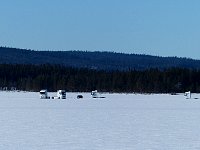
There are various ways to get from Umnäs (where I was) to Gällivare, where I needed to go next. (Well, technically, I needed to get to Kebnats, but that was a follow-up issue.)
The easiest way is to take the bus.
It runs about once a day and takes nine hours.
But I wanted to take it slowly and spend three or four days to make my way up there.
Partly because I wasn't sure how exhausted I'd be after the skiing (and I didn't want to start the dogsledding tour already worn out and tired), but mostly because I was on a vacation and why not take it easy for a while?
Technically, of course, I could have split the bus trip over multiple days, with staying, for example, in Storuman, Arvidsjaur and Jokkmokk on the way.
But then, I would have been stuck in the towns, so I could go shopping and see the city center, but wouldn't be able to go anywhere else.
And I would have stuck with the bus schedule, so on the first day, I'd be arriving in Storuman around 10 am. Too early to check into a hotel, so I would need to store my luggage somewhere and then walk around until the early afternoon. Or, inversely, towards the end of the trip I'd have to check out of the hotel in Jokkmokk and then hang around somewhere until 4 pm when the bus leaves.
Doable, but not my idea of fun.
A better idea would be to rent a car somewhere around Umnäs and then return it in Gällivare a few days later.
Which would have been a good idea if the same car rental company had offices in both places.
But, for example, Gällivare had only Hertz and Europcar, but the nearest Hertz rental stations to Umnäs were at Arvidsjaur and Lycksele. One already halfway to Gällivare and the other about 120 km in the wrong direction, so I would need to take a bus to get there and then drive back 100 km to get to the start of the road I wanted. Europcar was even worse, as the next station was in Umeå, near the coast, which would mean a four hour bus ride and a 300 km drive back, simply to avoid doing a nine hour bus ride to Gällivare.
And that was assuming that they were offering one way bookings in that area.
At some point, the most sensible option seemed to take the bus all the way to Gällivare, rent a car there and then do a three or four day round trip (like Jokkmokk, Boden, Lulaå, Lansjärv) in order to 'travel slowly', see the sights and be able to return the car from where I rented it.
Or (as there are no direct flights between Hemavan and Gällivare), fly from Hemavan to Stockholm and then back up to Gällivare. That
But the plan started to become more and more ridiculous.
After some other ideas (one involving a car that was, essentially, buried under the snow for the last two winters and had its engine removed and stored somewhere else; another involved flying from Hemavan to Stockholm and then from Stockholm back up to Gällivare), similar to what I did the previous year to get from Luleå to Hemavan), which led to plans that were even more ridiculous, I fell back to a rather simple plan.
It had only one drawback: It was expensive.
As I would be arriving at Hemavan airport (and departing from there), why not rent a car there, drive all the way up to Gällivare (and subsequently to Kebnats, where I really needed to go) and then use it to drive back to Hemavan, return it and fly home.
Immensely sensible, except for one fact: The car would be parked at Kebnats for the whole duration of the dogsledding trip, so I would be paying ten days of car rental in which I wouldn't use the car at all. And ten day of car rental fees (especially in Sweden) can be a lot.
Except that it turned out not to be.
There's a car rental chain in Sweden named Mabi (or sometimes called Hyrbilar), which is surprisingly large (more than 150 stations in Sweden). And they do have a rental station in Tärnaby. (Which is 'near' Hemavan airport.) Though they seem to be keeping that somewhat secret, as their list of rental stations on their English language web site doesn't list that location. But if you know that it exists (or speak Swedish, which, admittedly, most of their customers do), you can find it on their Swedish language web site.
And their prices are surprisingly affordable. Not cheap (it is Sweden, after all, so there's definitely no 10 Euro/day offer available), but a lot cheaper than, for example, renting a Fiat 500 for a day would be with Avis in Berlin.
While it was still economically stupid to rent a car and leave it parked somewhere for ten days, this cost for this went from prohibitively high to affordable. And it solved so many issues that I decided to go with that option. (All this to avoid a nine hour bus ride...)
So Kenneth did drive me up to Tärnaby and to the address of the rental station there. Where there was no sign of a rental station. And the address given on the booking form led to a large building housing "Tärna Fjällbuss", a bus tour operator. The building was some large bus/car service center.
And there was nobody there.
So Kenneth called the number given on the booking form and a short time later someone arrived by car, open one of the doors of that building and drove out my rental car.
Turned out that they hadn't expected me.
Or, specifically, they hadn't expected me to be on time.
The arrival time I had given (at which I wanted to rent the car) was close to the arrival time of the morning plane at Hemavan airport. And the rental station is called "Tärnaby/Hemavan".
So many people arriving per plane assume that Tärnaby and Hemavan are two places that are next to each other and that the rental station will be somewhere near Hemavan airport.
And only after arriving they find out that the Tärnaby rental station is more than 20 km away. And that there are no taxi stands at Hemavan airport. By the time they have figured it out and organized some transport to Tärnaby, it will be likely more than an hour before they make it to the rental place.
As the guy running the place had noticed that I was from Germany, he assumed that I would be arriving by plane and wouldn't know all of this, so it wouldn't be worthwhile to sit around the rental place and wait for me to figure things out.
But once it was sorted out that I already was at the right place (and that I had been in Sweden for more than two weeks by then and also knew where Tärnaby was located), things were surprisingly simple (almost scaringly so - but then, this was northern Sweden). He gave me the car keys, told me he would send me an e-mail with a link to a web site for payment and left.
(Paying the bill was harder than expected. The web site he sent in his first mail was one for Swedish citizen and required the entry of the Swedish personal identity number. Which essentially everyone in Sweden has (at least everyone old enough to rent a car). But which I hadn't. And without that, the site didn't let me proceed to payment. So I was getting worried that I might not be able to pay my rental fees. Fortunately this seems to be a 'known problem' and I got a second e-mail giving me a link that simply wanted my credit card information for payment.)
In any case - I had now a car available (and a nice one it was - I was only the second one to rent it, so everything was still shiny and new and the odometer was still less than a 1000 kilometers), so I said goodbye to Kenneth for now and drove to Arvidsjaur.
Next day I continued to Jokkmokk, but with a detour to a small lake named Abborrtjärnen to do some driving there.
There are a number of places in Sweden (most notably Arvidsjaur and Arjeplog), that are used by car manufacturers all over Europe to do winter testing for car prototypes. Most of it is done on custom built tracks (there are a number of them in Arvidsjaur and Arjeplog) with various characteristics. Some of the testing (mainly the endurance runs) is done on regular streets (you often see cars driving by with dazzle camouflage patterns to make it difficult to discern changes in the shape of the car and its bodywork). And some of the testing is done on tracks that are build on frozen lakes.
Although a lot of what happens on the lake tracks isn't testing, but more driver training.
Partly for the test drivers themselves, but also as an 'incentive' event, like this truck race I did see in 2014 while dogsledding.
There are also 'Drive Experiences' that you can book, where you can learn to drive a car on snow and ice. But those are usually done with luxury sport cars, like new Porsche cars, Jaguars, Audis, BMWs, Ferraris and Lamborghinis. And while it is doubtlessly a great experience, it is massively expensive (around 4000 Euro/day). So while it surely makes a nice incentive to give for the best car salesmen in Europe or the investment managers with the largest profits, it's way too pricey as something to do as a side activity on a regular holiday. (And that's assuming everything goes well. In general, there's no option for a full protection waiver insurance on these experiences. I think in one case the drivers liability was 'limited' to 25000 Euro. So if you roll your car on the ice, it'll be an even more expensive vacation.)
On the other hand, creating a track on a lake isn't that expensive. You (basically) only need access to a lake and a large snow plow. Creating a track on a lake isn't inherently more difficult than maintaining a cross-country skiing trail. And you can use those for free...
There's also no need to use an expensive, high-end sports car. Acceleration and top speed are irrelevant on ice tracks. And most of the modern features that make driving safe, even on ice (and which are the primary reason why car manufacturers do testing in northern Sweden in the first place), will presumably switched off for those events in any case. (As there is little point in training driving on ice if the car behaves as if driving on regular streets.)
So why not pick a small lake somewhere and buy some cheap and barely functioning cars? (Who cares whether the lights work. Or the windows open. Or whether all doors work. Or the alternator provides power. Or whether there's still door paneling on the inside. As long as it moves, steers and brakes, it'll do. If someone crashes the car and puts some dents in it, it'll hardly be noticeable and can be repaired with a sledgehammer. And if someone really damages the car beyond repair, then it's not much of a financial loss.)
At least that is what someone near Abborrtjärnen thought and put an 1.6 km long track on that lake.
Somewhat oddly, to be able to drive on snow and ice, I needed to drive on snow and ice to get there.
In general, Swedish winter road maintenance is amazing.
On all main roads the snow is meticulously removed.
And that's not a simple "let's run a snow plow over it to get rid of some of the snow".
It's more a "when we say we clear the road of snow, we mean it".
Although, admittedly, there's little they can do about the occasional snow drift on a windy day.
(But somehow it feels like someone will come out with a broom within a minute or so to clear that away as well.)
In short, driving in Sweden in the wintertime is like summer driving anywhere else, as long as you stick to the main roads. (Though at lower temperatures, obviously. And with more reindeer.)
It's slightly different on side roads, though.
While they are still well maintained, its done more by flattening the snow than by removing it.
So to get to a snow track, first needed to drive about 40 km of snow road. But that's with a new car with four-wheel drive and all driving assistants enabled (well, except for the lane assistant, as that obviously wasn't able to figure out where the center line of the road was), so it was an easy drive without any problems.
After all that build-up text, there's not that much to tell about the track driving itself.
The main thing I noticed was that I'm not a daring driver and didn't have the nerve to go with speed around the corners, attempting to drift. In general I tried to drive at the highest speed at which I would still have control of the car. And if I went to fast and the car lost grip, I automatically tried to stabilize it again, instead of "going with the flow".
There was only one corner, where there was even a bit of slide.
At least I know now that, if a car I am driving has lost grip, I'll probably automatically do the right things to get it under control again.
Unless, of course, a camera is running...
Somewhat annoyingly, I managed to drive 90 minutes on the track without even running once into the snow at the side. But then I put a camera on the dashboard to have a video of the track layout. And half a lap later, I went straight into the snow wall. Obviously trying too hard to do a properly impressive lap. And it doesn't even look exciting of video - I'm slowly coming to a halt and that's it.
In any case - even without cool looking drifts or dramatic accidents, it was a lot of fun to drive around the lake.
The weather was great, it was an interesting and unusual activity and it did cost a lot less than an ice driving experience course in Arvidsjaur and Arjeplog. It wasn't cheap, though, as you are essentially renting a whole racing track for your exclusive use for two hours. But it was safely in the "affordable and worth it" range.
It was then another 40 km back along snow covered roads to get back to the main road towards Jokkmokk, but being back in a 'proper' car, I managed to get there without ending up in a snow drift.
Next day I drove on to Gällivare (with a couple of stops and detours along the way).
I had one more 'free' day before the dog sledding tour would start, so I decided to use that to drive to Jukkasjärvi and have a look at this year's ice hotel.
I had been staying there for two nights the previous year (more about that here), but as the ice hotel melts in summer and is rebuild every winter, it would look differently.
I wouldn't spend the night there (it is kind of expensive and the 'kind of expensive' things had already been adding up on this vacation), but it would clearly be worth driving the 120 km from Gällivare to have a look.
Somewhat surprisingly, the general layout was the same.
One long corridor running along one side of the building with the main entrance in the middle.
The Ceremony Hall opposite the entrance. Going down the main corridor to the right, two corridors branch off leading to regular ice rooms. (Which contain a bed and some large 'ice pillars'.)
Going down the main corridor to the left, two more corridors branch off, leading to the themed 'Art Suites'.
I don't know when they ended up with that 'standard' layout, which keeps the basic structure the same. When I was there in 1997 it looked completely different. Presumably it makes it easier and cheaper to build the ice hotel every year, as they can reuse the same scaffolding and templates for creating the building and then let the artists loose to design the individual rooms.
The Ceremonial Hall looked playful this year. It is mainly used for weddings, but also for product presentation and company events. Nowadays it is intentionally devoid of any kind of religious elements.
 |
(Way back in 1997 it was still the 'Wedding Chapel' and recognizably so, including a small altar and lectern on the podium. It was also a separate building.) |
Last year, the hall was dominated by the shape of a large, barren tree carved into an ice wall. A large circular structure visible behind it made it look a bit Japanese.
The look of the 2022 Ceremonial Hall was less rooted. It was filled with large white balloons made from snow and ice, which were placed in ways that made it look like they had floated to the ceiling.
An idea that worked incredibly well. Ice sculptures are heavy and, in most cases, look that way.
Here it really felt like you could give the balloons a push and they would float away.
It also worked well in context. Lots of weddings use balloons (often white ones) as decorations or to release them to the skies after the wedding. But balloons are also children's toys and convey a fun and playful mood and liven up the room.
The first of the 'Art Suites' I went into was called 'Blue Tundra'.
It was dominated by a large circular design on the wall opposite the bed and some abstract ice shapes waving along the ground. I first assumed that they were representing the norther lights. But there were small 'reindeer antlers' poking out between them. The real theme behind this seems to be about reindeer herding, with the animals driven into a fenced area,
I didn't recognize the themes or ideas behind rooms Ginnungagap, Inom and Molecules. All of them looked interesting, but somewhat abstract.
Ginnungagap had soft-shaped pillars in translucent white (as opposed to the more common blocky transparent ice pillars) and looked a bit like the roots of giant teeth. (Although, according to the dictionary, Ginnungagap is the empty room/space at the beginning of history.)
Inom featured a hollowed cube to walk through (with some round peepholes on top and on the sides) and three illuminated ice stripes over the bed. (It might have helped to know that 'Inom' is Swedish for 'within'. But not much.)
Molecules were essentially large round sections that were interconnected. (The idea behind it is that it represents a single water molecule, so the large room is the oxygen atom, with the two smaller spherical sections representing hydrogen atoms. A good idea in a room that's literally made out of water, but not immediately obvious.)
There were also three other 'abstract' rooms with a more 'decorative' design - Different Natures, Great Gatsby and UV.
Different Natures was one of the rooms that deviated from the 'flat, pressed' snow looks of the walls and opted for pattern of circular holes all over the wall, making it look a bit like Victorian-times furniture. (I didn't know what it was called, but the proper term seems to be "tufted furniture".)
(Or, if you're uncharitable, it also looks a bit like a padded cell.)
The official explanation is that it is supposed to evoke associations with big ice boulders and carved water shapes, which it doesn't look like at all.
If Different Natures feels slightly Victorian, then the Great Gatsby room feels more than a bit "1920's", using Art Deco design elements.
The UV room obviously is more about colour than it is about shape. (I found it a bit disappointing that the 'woven' pattern on the ceiling was made with string instead of being etched into ice.)
So far, the art suites had been abstract designs, but the remaining five featured more realistic depictions of things.
First one was the Sacred Giant, featuring the tusks of a mammoth head protruding into the room. It looked impressive and fitted well into the ice-age/ice-cave theme.
No Pressure had everything in a screw clamp. The bed was being under pressure from both sides of the wall. The columns were squeezed from the top and the bottom and even the Earth was about to get squashed. (Which, to me, looked a bit like the logo of the 'Clamp' company from the second Gremlins movie.)
Dickensian Street is pretty much what the name suggests - a row of houses (carved from ice) in Victorian London, complete with St Paul's Cathedral (carved in snow) in the background.
Room Service was probably the strangest of the rooms, featuring a somewhat animalistic representation of servants (monkeys and dinosaurs) doing more damage than good - breaking the wine glass, smashing the chandelier, ripping the curtains, dropping the roasted chicken to the floor...
Unfortunately, but somewhat appropriate for a room that has vandalism and unthinking destruction of property as a theme, someone had knocked off the horn from the triceratops between the first and the second time (about an hour later) I went into that room. (It's a bit difficult to see, but in the second image the horn is lying on the ground in in front of the dinosaur.)
To bed with the chickens features a Quonset hut (a long half-cylinder, tube-like building made from corrugated steel), repurposed as a chicken shed. But made of snow and ice instead of steel.
The room has many small details, like a small 'petrol lamps' next to the bed, or discarded wagon wheels. I think it's also the first room I've seen in the ice hotel that has 'windows' placed in the walls (not that they lead anywhere, but it makes the room look less like a bunker). The wall opposite the bed has eleven 'chicken nests' for the birds to roost and lay eggs. There are also chickens all over the place.
And that was the last of the art suites in the 'Icehotel Winter' (or 'Icehotel 32', as it was the 32th incarnation of the icehotel).
Although it's not the last of the new suites. As they say in crappy commercials: "But Wait, There's More!"
There's not only the 'Icehotel 32', but also the 'Icehotel 365' (not named this way because it's the 365th incarnation of the ice hotel, but because it is open all year round).
While the winter version of the icehotel is closed in mid-April and then melts in summer, the 'Icehotel 365' is (essentially) a giant refrigerator where ice rooms survive the summer (and can be booked all year). Often the rooms in there are more elaborate, as they exist for a longer time (typically three years).
But even with some rooms remaining essentially unchanged from the previous year, some had been replaced by new rooms. So there were some art suites in that building that I hadn't seen before.
The three new rooms were Strobilus Land, Wanderlust and A Midsummer Night's Dream,
Strobilus refers to tree cones, here specifically to those of spruce trees.
In this case the mapping from the name to the room is straightforward: The room is full of spruce cones, some of them carved in snow, some of them carved in ice.
The Wanderlust art suite evokes less the feeling of wondering and exploring, but more the imagery associated with that period, like the pictures of Caspar David Friedrich. Or, even more so, the somewhat kitschy 'outdoor' images that made it into living rooms, featuring a bellowing stag in a forest glade, right next to a waterfall or a mountain goat on top of a bare mountain.
The designers picked a mountain goat and a waterfall as icons representing the 'Wanderlust' era and put ice sculptures of them in the room.
Finally, the last new suite, 'A Midsummer Night's Dream' was one of the rare rooms that used additional materials with the snow and ice: Plants embedded in ice blocks.
The art suites that were still there from the previous year were Blue Houses, Cabinet in the Woods, Crescents, Dancers in the Dark, Dreaming in a Dream, Early Spring, Hang Loose, Kodex Maximus, Lost and Found, Raindrop Prelude, Sauna, Teckara, The Drift, Toybox and You are Here.
I won't go into much detail about those 15 rooms as I already described them in my page about the visit there in 2021.
So there are 15 old rooms and only 3 new ones. This is a surprisingly low number, as the 'lifetime' of a room in the Icehotel 365 is supposed to be about three years. So the expectation would be that they change 6 out of a total of 18 rooms each year.
Most of the rooms seem to survive the passage of time surprisingly well, but a few rooms started to detoriate a bit.
In some cases I a not sure whether that gives a room a bit of 'patina'. And whether that improves it.
A borderline case were the 'paintings' hanging in the 'art gallery' of the Hang Loose art suite were now covered with a layer of rime. I prefer the earlier 'fresh' look, but the new one works as well.
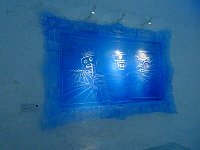 |
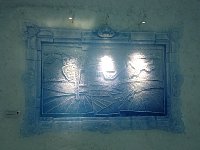
|
| 2021 | 2022 |
Some parts had gotten better with age. The 'bathrobe' in the Sauna room had been a bit glossy in 2021, but with the added rime on top of it, it looked softer and more 'fluffy'.
 |
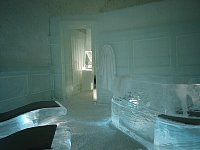
|
| 2021 | 2022 |
But the Toybox suite had fared badly. Not only had the spelling blocks become more difficult to read (in 2021, the word "Welcome" was immediately recognizable, while in 2022 it was more a case of looking at the individual blocks to figure our whether they spelled something), but the cute rabbit had lost one of its ears - and that kind of damage to the room should have been repaired. (Especially as this is a Deluxe Art Suite that costs nearly a thousand Euro per night. Though, as Deluxe Art Suites go, this is the least expensive of them...)
 |
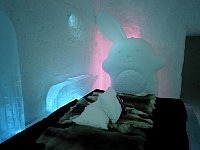
|
| 2021 | 2022 |
Something I was oddly happy about was that I had been sleeping in a 'museum piece' the previous year.
They have a room called the Experience Room. an exhibition about the 32-year history of the icehotel, which also features "selected pieces of art that have been preserved from previous years".
And one of these pieces was a small segment of the 'hot dog stand, reclaimed by tree roots' of the 'Paradice lost' suite in which I spent a night in 2021.
It's a bit difficult to make out in the picture I took in 2021 (I didn't know that this section would be featured in the Experience Room a year later. But I marked the approximate area.)
That might have been a good time for a celebratory drink (it doesn't happen often that I find out that I spent a night next to 'distinguished artwork', even if it's simply a section of a hot dog stand, carved from ice), but I needed to drive back to Gällivare. And Sweden has a rather draconian view on drinking and driving.
So I didn't have a drink at the ice bar and only took a picture before I left.
Outside the weather was suitable for a vacation day - warm and sunny.
Which is usually a good thing, but it got me a bit worried, as it's not that good for dog sledding.
Of course, if there have been a couple of really cold days, preferable with a bit of snowfall overnight, it's great to be on a sled with the sun shining and 10°C plus.
But daytime temperatures have been above freezing for the last two weeks and the area outside the ice hotel showed the result (and that's not ice).
And the situation was similar in the places I had visited the previous days, like on a street crossing in Jokkmokk, a nearby lake.
I've also been walking through slush in Arvidsjaur and stepping into deep puddles in Gällivare.
There was a lot of water in fluid form around and I was wondering what that would mean for the dog sledding tour.
In the end, it turned out all right, but there were a lot of changes to our route. (As a matter of fact, to all of it. We didn't manage to go to any of the places that were on the original plan. And even the day-by-day plans did sometimes change on short notice. Fortunately that doesn't matter much on dog sledding tours.)
More about the dog sledding part of the vacation is on the next page, which can be reached here.